01 Subway:
At the B1 floor of the airport, you can take the Daxing Airport Line and reach the Caoqiao Station of Line 10. After that, transfer to Line 10, Line 14, Line 7 and other lines from Caoqiao Station to reach different locations in downtown Beijing. It only takes about 19 minutes from the Daxing Airport Line to Caoqiao Station, which is relatively fast.
The operating hours are from Caoqiao Station to Daxing Airport Station from 05:41 to 22:30, and from Daxing Airport Station to Caoqiao Station from 06:00 to 23:00.
02 Intercity railway: At present, Daxing Airport has opened lines such as the Beijing-Xiong’an Intercity Railway. You can take the intercity railway to stations such as Beijing West Railway Station and then transfer to other means of transportation to reach your destination in the urban area. However, the number of intercity railway trains is relatively limited, so you need to understand in advance and arrange your trip according to the schedule (you can ask the staff).
03 Airport bus:
The airport bus is divided into urban buses and inter-provincial buses. Urban buses are convenient for passengers to travel between Beijing urban areas. There are routes to many urban stations such as Beijing Railway Station, Beijing West Railway Station, and Wangfujing.
The bus station is located in the east on the first floor of the airport terminal. There are signposts in the airport. At present, tickets are only sold through mini-programs or automatic scanning ticket vending machines. The one-way fare for an ordinary adult is 40 yuan.
04 Taxi/online car-hailing:
You can take a taxi directly to the urban area at the taxi pick-up point outside the airport parking lot. For online car-hailing, you can get on at the 1M floor (mezzanine) of the P1 parking building. This way is the fastest and most convenient, but the cost is relatively high, about 200 yuan.
At first, when looking at hotels, I was really a bit discouraged. As expected, in the capital where every inch of land is precious, a room of only ten or so square meters is small in space and costs five, six, seven or eight hundred yuan at every turn. I really can’t bring myself to book it. Finally, I decided to turn to homestays. Later, I booked a hotel apartment next to Songjiazhuang subway station (Lines 5 and 10) on the third ring road. It is a duplex. Downstairs is the living room and bathroom (with shower). Upstairs, there are two beds and a bathroom. There is a Fumao MALL nearby with many places to eat. After this stay, I think it’s overall not bad. The only disadvantage is that it is still a bit far from the major scenic spots. Except that it’s only three stops directly to the Temple of Heaven, it takes about 40 minutes to transfer by subway to Tian’anmen. It is recommended to choose a homestay in the area north of Tian’anmen and look for it between Tian’anmen and Yuanmingyuan, which will be more convenient.
The most troublesome thing in Beijing is the reservation of major scenic spots. Looking at it, it is said that the scenic spots around Tian’anmen are very difficult to grab. In actual operation, basically as long as you can reserve at the right time, you can get it. It is recommended that for the Great Hall of the People and Tian’anmen Tower, which may be temporarily closed, you can reserve an extra day as a backup. This time we encountered it. For the first time, we received a text message notification of ticket refund. Tian’anmen Tower is closed all day. Fortunately, we made two-handed preparations and reserved another day later so as not to leave regrets. In addition, the security check around Tian’anmen is very strict. Try to bring as few things as possible. It is best not to bring a bag, which can save a lot of time.
It is worth mentioning that the entrance tickets for scenic spots in the capital are really conscientious. The most expensive Forbidden City is only 60 yuan. In comparison, the entrance tickets for 5A scenic spots in other parts of China are much cheaper.
[Great Hall of the People]: Closed on Mondays. Reserve 3 days in advance through the WeChat mini-program “Reserve for Visiting the Great Hall of the People”. Tickets are released at 12:30. If you can’t get tickets at 12:30, you can still enter and check at 12:50. Many people said they got tickets at 12:50. Adult ticket price is 30 yuan. You can bring a bag, but you cannot bring any liquids.
[Tian’anmen Tower]: Closed on Mondays. Reserve 7 days in advance through the official account “Reserve for Visiting Tian’anmen Tower”. Tickets are released at 17:00 in the afternoon. There is no way to fill in the visitor information in advance. On the computer side, you can submit the prepared information and copy and paste. On the mobile phone side, you can use the shortcut keyboard of iPhone to set up shortcut phrases for the visitor’s name and ID card in advance. Adult ticket price is 15 yuan. You need to store your luggage in advance and only bring mobile phones, cameras, and ID cards.
[The Palace Museum]: Closed on Mondays. Reserve 7 days in advance through the mini-program “The Palace Museum”. Tickets are released at 20:00 in the evening. Adult ticket price is 60 yuan. Treasure Gallery is 10 yuan. Clock Gallery is 10 yuan. Elderly people over 60 years old get half-price tickets. It seems relatively easy to reserve on non-holiday days. At the beginning of the test, I entered and waited before 20:00, but when the time came, I always got a prompt that there were too many people and I couldn’t get in. Later, I found that there were still tickets available after 9 o’clock, so I wasn’t nervous anymore. Later, when actually reserving, I clicked on “Ticket Reservation” and entered at 20:00. I tried twice and it was very smooth. There was no more prompt that there were too many people.
[Flag Raising Ceremony at Tian’anmen]: For the flag raising ceremony, flag lowering ceremony, and Tian’anmen Square, all can be reserved through the mini-program “Reserve for Visiting Tian’anmen Square”. It’s not difficult to reserve on non-holiday days. In addition, if you have reserved the Chairman Mao Memorial Hall, the Great Hall of the People, the National Museum, Tian’anmen Tower, and the Forbidden City, you don’t need to reserve Tian’anmen Square separately.
[National Museum]: Closed on Mondays. Reserve 7 days in advance through the mini-program “National Museum”. Tickets are released at 17:00. Free admission. Considering that my family is not very interested in cultural relics, I didn’t arrange a visit this time. But I also took a look. I found that it is still relatively difficult to reserve tickets for the National Museum. Basically, it is fully booked within a few minutes after the tickets are released.
[Military Museum of the Chinese People’s Revolution]: Closed on Mondays. Reserve 8 days in advance through the mini-program “Ticket Reservation for the Military Museum of the Chinese People’s Revolution”. Tickets are released at 8:00, 17:00, and 20:00. You can fill in the visitor information in advance in the personal center. Free admission.
[Old Summer Palace]: Adult general ticket is 35 yuan. There is no need to reserve in advance. You can buy tickets on the mini-program “Tickets for the Old Summer Palace Ruins Park” when you arrive at the entrance on the same day. It is open as usual on Mondays. There is also an Old Summer Palace Museum Exhibition Hall inside. It is closed on Mondays but is open as usual on Mondays when there are national statutory holidays.
[Tsinghua University and Peking University]: You cannot make reservations on Mondays. Peking University is only open for reservations on weekends. Reserve 7 days in advance on weekends. Tsinghua University can be reserved on weekdays. Tickets are released 1 day in advance.
[Badaling Great Wall]: Just buy tickets in advance. It’s not difficult to reserve on non-statutory holidays. Adult ticket price is 40 yuan.
[Temple of Heaven]: Closed on Mondays. It’s not difficult to reserve on non-statutory holidays. Adult ticket price is 34 yuan.
[Bird’s Nest and Water Cube]: Just take pictures of the night view. Personally, I don’t think it’s necessary to spend money to go inside. In addition, there are battery cars on the square for 20 yuan per person, which just take a lap around the periphery of the square. Personally, I don’t recommend taking it. It’s not necessary.
Day1 Chairman Mao Memorial Hall – Great Hall of the People – Military Museum of the Chinese People’s Revolution
[Chairman Mao Memorial Hall]
Take Subway Line 1 and exit at Exit C of Tian’anmen East. As soon as you come out, it is the security checkpoint. First, swipe your ID card to check the reservation record. Continue to line up. Swipe your ID card again. Let your bag go through the machine and have a full-body check. Finally, your bag will be opened for inspection. On non-holiday days, if you arrive at 7 or 8 in the morning, it will take 40 minutes to an hour after going through these several inspections. Just think, if you come during the May Day or National Day holidays, it is estimated that all the time will be spent queuing. Entering Tian’anmen Square, on the left is the National Museum, on the right is the Great Hall of the People, in the middle is the Monument to the People’s Heroes, and behind the monument is the Chairman Mao Memorial Hall. We reserved for 9:30 – 10:15. When we arrived at 8:47, the security guard at the entrance of the luggage storage area didn’t let us in and said we had to wait until 9 o’clock. It also seems to depend on the person. Maybe if we encounter a less strict security guard, we will be allowed to enter. After storing the luggage and going to line up at the memorial hall, at the entrance, we were searched again. There is a small flower-selling window at the entrance. A bouquet of three flowers is 9 yuan. When entering the memorial hall, you need to take off your hat. Photography is not allowed. As soon as you enter, there is a solemn and solemn feeling. The visiting crowd also consciously keeps quiet. You cannot stop at all. You will come out in about five minutes.
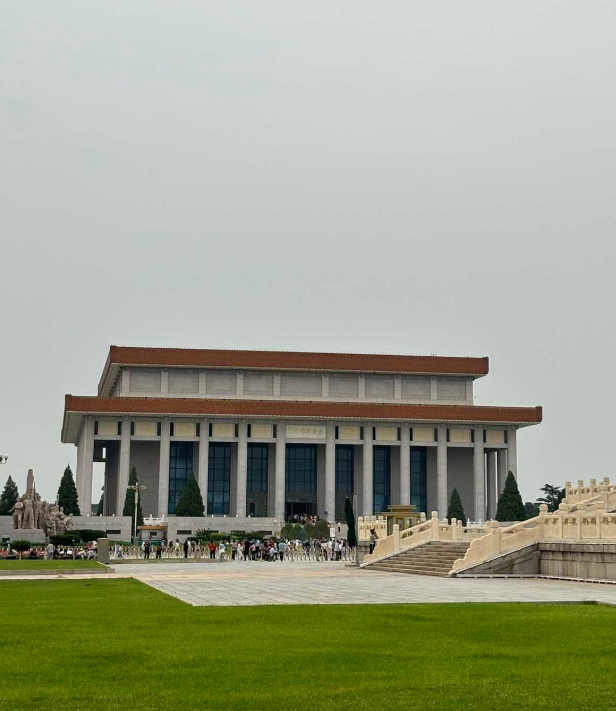
Entrance of the memorial hall
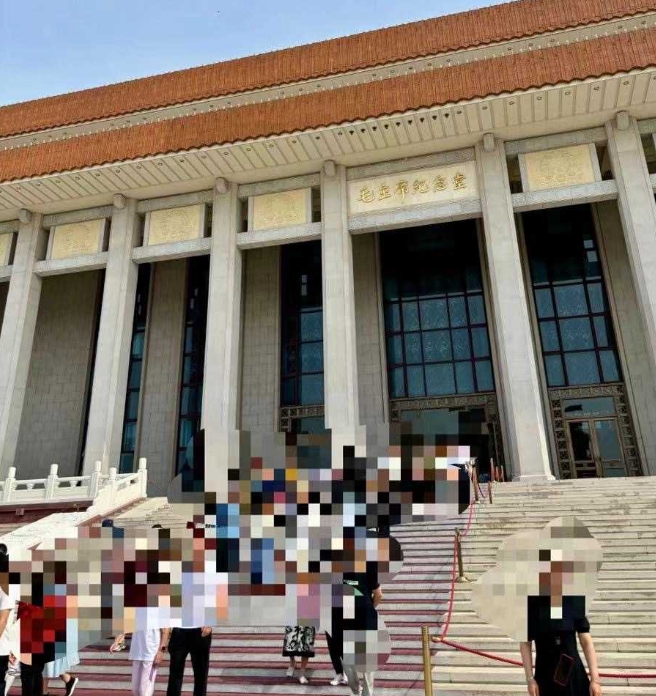
Exit of the memorial hall
[Great Hall of the People]
You can bring a bag into the Great Hall of the People, but you cannot bring liquids. You can bring an empty bottle. At the exit after the visit, there is a free water supply point and disposable paper cups printed with “Great Hall of the People”. There are many chairs inside for rest. You can walk and look slowly. Each Chinese province and region has a hall named correspondingly, but not all are open for visits.
Visit route: Entrance, Central Hall, Hunan Hall, go upstairs to the second floor, Liaoning Hall, Auditorium for ten thousand people, East Hall, Welcoming Hall, Banquet Hall, Shanghai Hall, Guangdong Hall, go downstairs to the first floor, Sichuan Hall, Press Conference Hall, Exit.
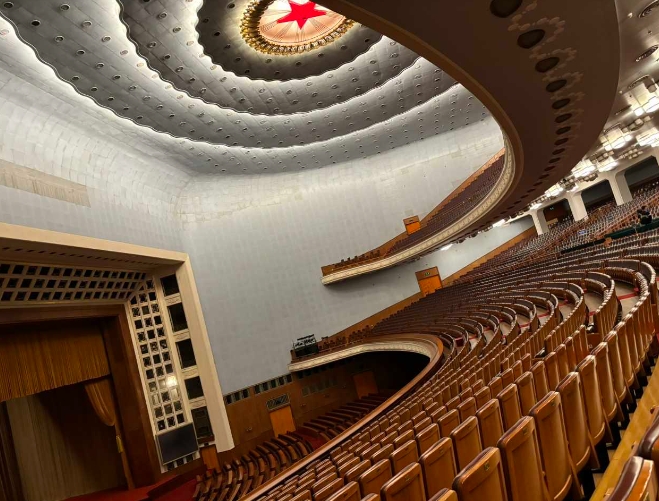
The five-pointed star in the auditorium for ten thousand people
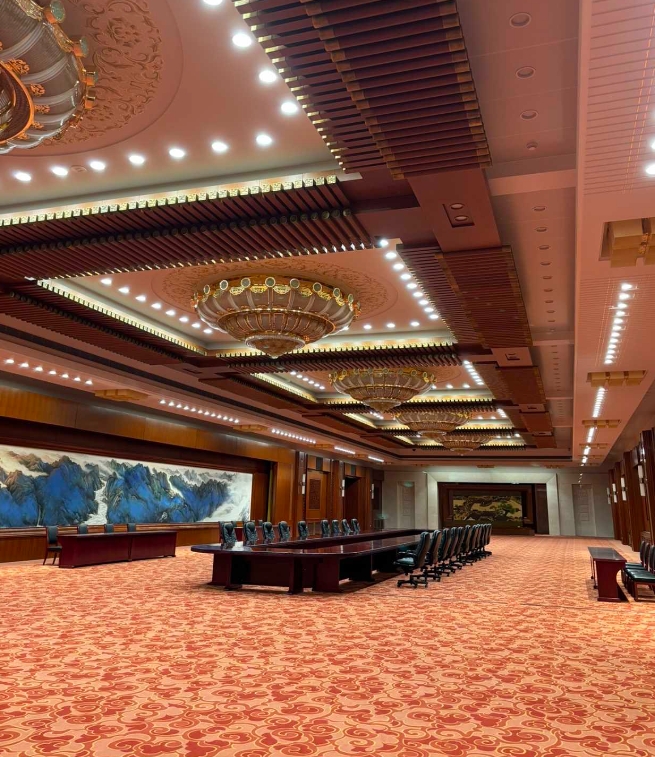
East Hall
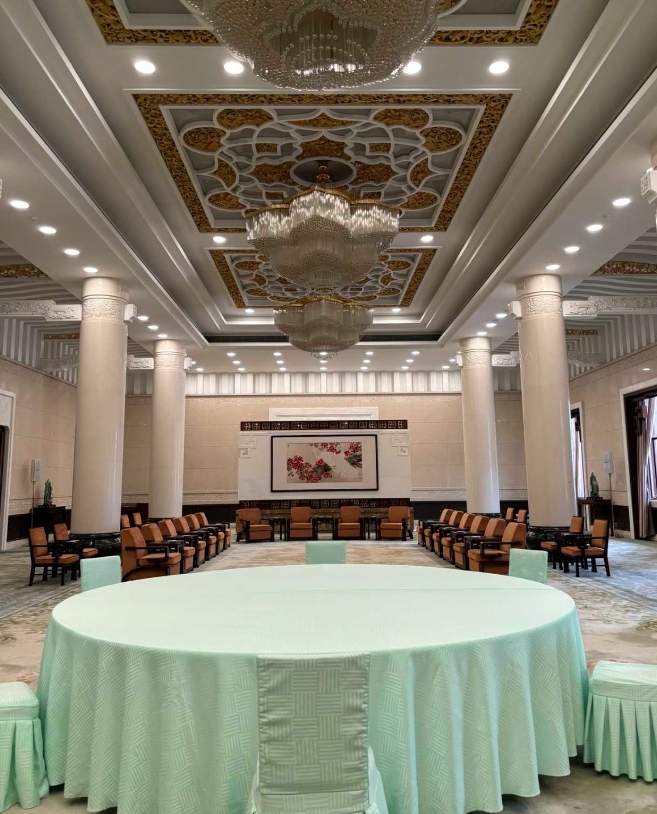
Guangdong Hall
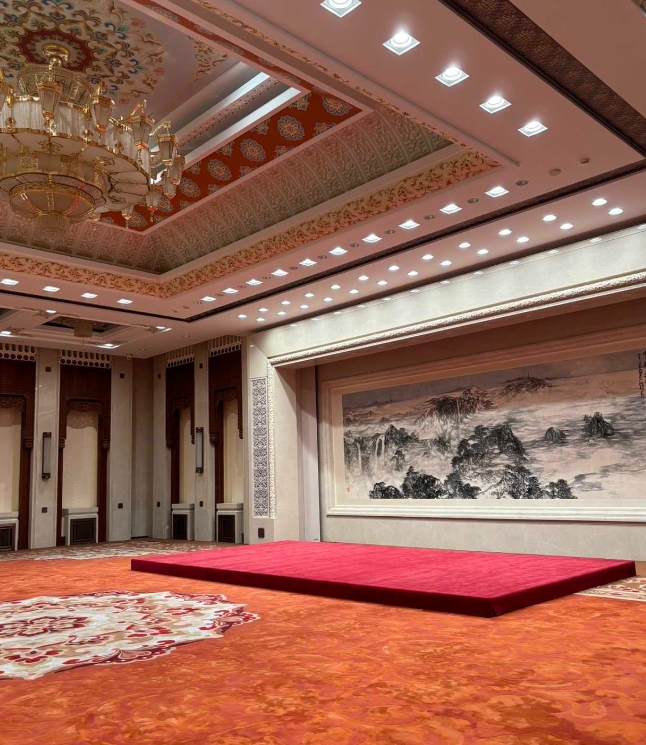
Press Conference Hall
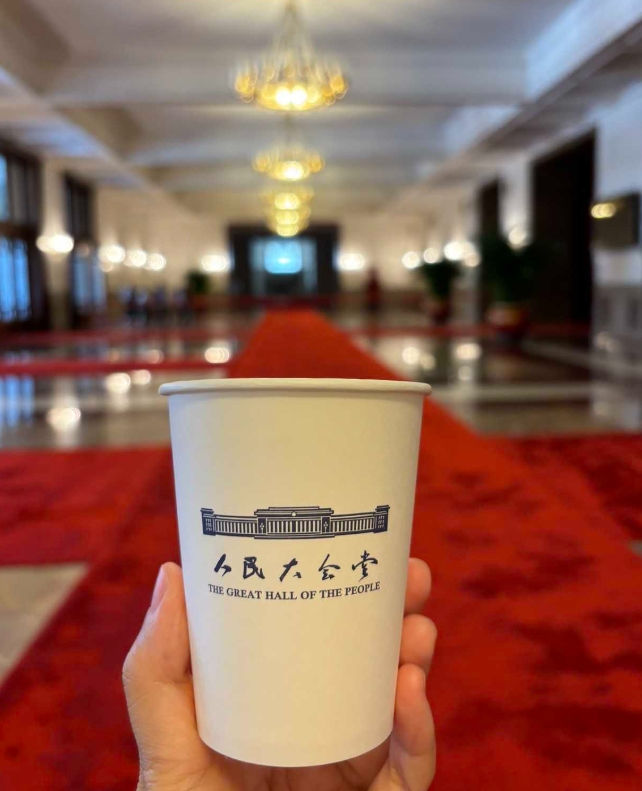
Central Hall
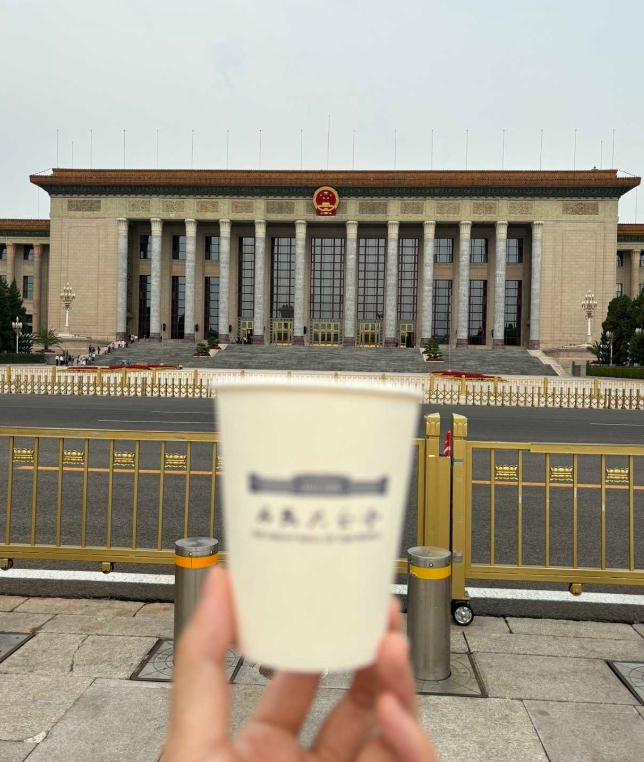
Exterior of the Great Hall of the People
Around 11 o’clock, we came out of the Great Hall of the People. We asked the security personnel about the nearest taxi pick-up point. We crossed the road to the Guanqi Hotel and took a Didi to Ziguangyuan in Dashilan. Then we found that we actually shouldn’t have taken a taxi. In fact, going down from the Guanqi Hotel is the Dashilan area in front of the gate. There are many alleys where cars can’t enter. In fact, the Didi car just took us around to the other side, and then we still have to walk in. When we arrived at Ziguangyuan, we waited for about 15 minutes. We ordered roast duck, Beileye barbecue, Qianlong cabbage, yogurt. The food is quite good. My family was also very happy eating. Yogurt is 8 yuan a cup. Buy five and get one free. The four of us stubbornly ordered five portions. Then my dad tried it and said it wasn’t delicious. In the end, the three of us each ate two. Sure enough, everything is too much of a good thing. If you eat too much, it won’t taste good anymore. Personally, I think it has a strong milk flavor. Those who like dairy products can try it.

Delicious food at Ziguangyuan
In early June, the weather is cool in the morning and evening, but the temperature of over 30 degrees at noon is still quite hot. Because we live in a relatively remote place, it is also troublesome to go back and rest at the homestay. So when arranging the itinerary, from noon to afternoon, we try to find indoor environments to escape the heat as much as possible. After eating roast duck, we took a taxi to the Military Museum of the Chinese People’s Revolution. The reason for choosing the military museum is that it is relatively easy to reserve tickets. Also, I think my dad likes watching war movies. Compared with the national treasures in the National Museum, looking at revolutionary weapons in the military museum may be more interesting. As a result, after mom and dad took a quick look at the fighter jets on the first floor, they found two benches and rested separately. My aunt was full of energy and walked around everywhere. There are many children, especially little boys, who listen with great interest following the commentator. It is recommended to bring children to the military museum. It may be more suitable than the National Museum.
Basement: [Weapon Hall, Light Weapon Exhibition Area, Heavy Weapon Exhibition Area] Display of various rocket launchers, tanks, and armored vehicles, full of mecha feeling.
First floor: [Weapon Hall, Military Technology Exhibition, Naval Technology Exhibition Area] Various fighter jets and submarines are very shocking.
Second floor: [Revolutionary War Exhibition, Weapon Exhibition (including light weapons, etc.), Military Technology Exhibition, Naval Technology Exhibition Area, Nuclear Technology Peaceful Utilization Exhibition Area, Missile Technology Exhibition Area] Display of different models of pistols, rifles, and submachine guns.
Photo Spots
√H-6 bomber: One of the longest-serving aircraft types, in the central hall on the first floor.
√Dongfeng-1: In the central hall on the first floor.
√Meritorious fighter 079: The MiG-15 fighter jet once piloted by famous combat hero Wang Hai.
√Aircraft carrier group: Themed exhibition hall on the first floor.
√Meritorious tank: The only tank of the People’s Liberation Army’s first tank unit.
Interactive Locations on Basement 1
①B1 shooting experience: Make an appointment through the official account.
②B1 99A tank simulation: Line up on site to get a number.
③F1 unmanned aerial vehicle simulator: Line up on site to get a number.
④F2 cruise missile: Line up on site to get a number.
⑤F2 aircraft carrier roaming: Line up on site to get a number.
⑥B1 red movie: Make an appointment through the official account.
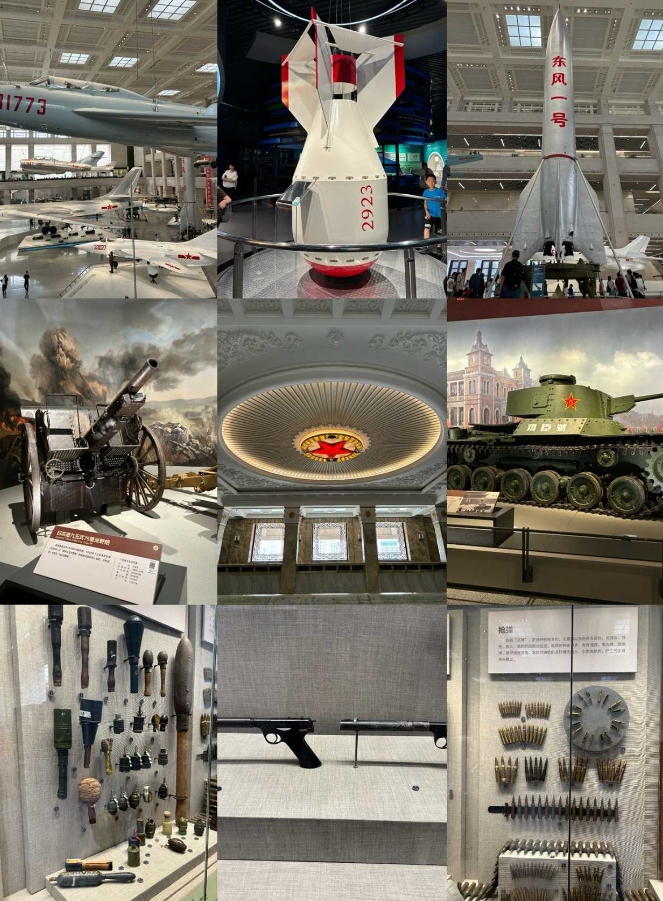
Chinese Military Museum
Yuanmingyuan Ruins Park
The next day is Monday. Most scenic spots are closed. The remaining options are Yuanmingyuan, Summer Palace and the Great Wall. After comprehensive consideration, the Summer Palace is given up (the small scenic spots inside are not open on Monday). For Yuanmingyuan, it is recommended to enter from the east gate. The east gate is close to the Western-style Buildings ruins. After browsing, take a cruise ship at the entrance of the Western-style Buildings to the south gate. Turning left 200 meters after exiting from the south gate is the school gate of Tsinghua University. This is a relatively time-saving and labor-saving route. We did it in reverse. We took the subway and entered from the south gate. As a result, walking more than one kilometer from the south gate to the Western-style Buildings ruins area made our family tired.
The entire Yuanmingyuan scenic area has three gardens, namely Qichun Garden, Changchun Garden and Yuanmingyuan Garden. If you really want to walk through all of them, it will take at least a day. Now we can only look at the ruins and broken walls and imagine the prosperous times of the past. Recommended tour route. However, the east gate is far from the subway station. You can ride a shared bicycle to the east gate after getting out of the subway.
Western-Style Buildings Ruins Area
Construction began in 1747 (the twelfth year of the reign of Emperor Qianlong) and was basically completed in 1759 (the twenty-fourth year of the reign of Emperor Qianlong). It covers an area of 80,000 square meters. The main buildings include Xieqiqu, Yellow Flower Maze, Bird Cage, Square Exterior, Five Bamboo Pavilions, Sea Calm Hall, Faraway Viewing Pavilion, Grand Waterworks, Water Viewing Method, Linear Mountain, Square River, Linear Painting, etc. The Western-Style Buildings is a European-style garden with fountains as its main feature. Its architectural form is in the “Baroque” and “Rococo” styles, while also incorporating elements of Chinese gardens. The Western-Style Buildings were designed and directed by Western missionaries such as Giuseppe Castiglione from Italy, Michel Benoist from France, and Ignatius Sichelbarth from the Czech Republic, and built by Chinese craftsmen. In 1786 (the fifty-first year of the reign of Emperor Qianlong), the “Copper Plate Prints of Western-Style Buildings” created by court painter Yilantai was completed. The Western-Style Buildings is a successful attempt at large-scale imitation and construction of European gardens and architecture in China and holds an important position in the history of cultural exchanges between China and the West.
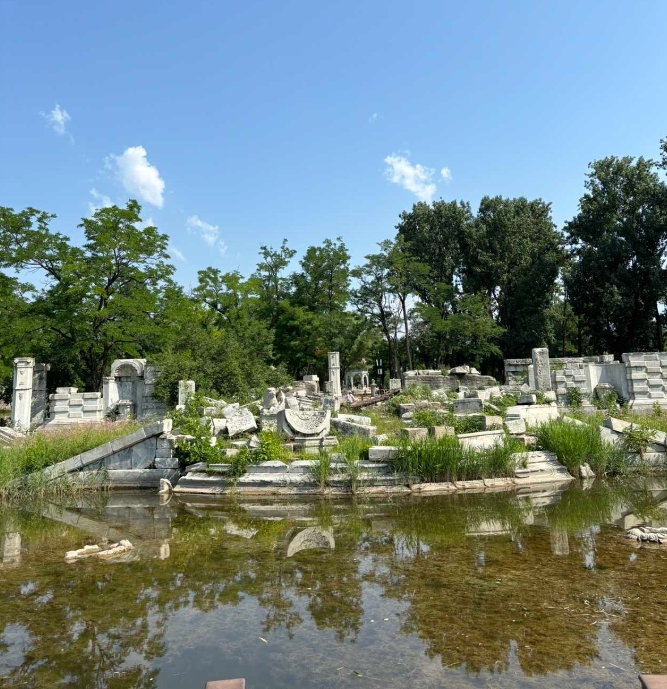
Western-Style Buildings Ruins Area
Sea Calm Hall Twelve animal head fountains. Seven animal heads have been recovered, and the whereabouts of five animal heads are unknown. Among them, the horse head is displayed in the Yuanmingyuan Museum (in Zhengjue Temple at the south gate. It is said that buying a museum ticket for 10 yuan allows you to enter Yuanmingyuan without buying another entrance ticket). However, it is usually closed on Mondays (it will be open on Mondays on statutory holidays).
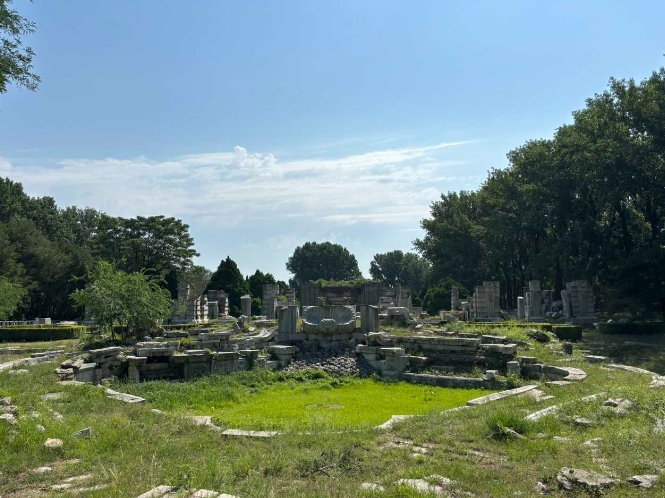
Square Exterior The mosque where Princess Fragrant attended worship
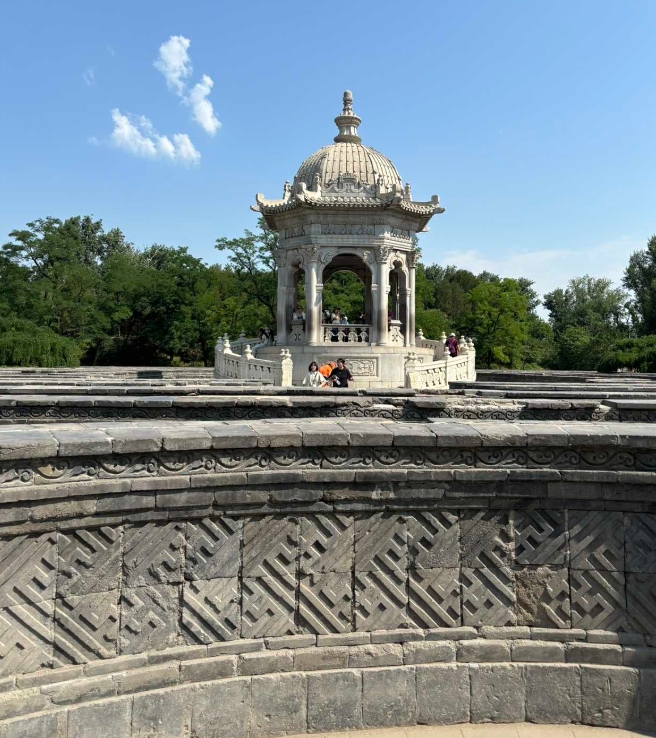
Flower Maze I was really dizzy walking through it
Take a cruise ship at the exit of the Western-Style Buildings Ruins Area. 35 yuan per person, one-way. Getting off at any pier ends the journey. First, it sails to the west pier (going down is Yuanmingyuan). After touring Fuhai Lake, transfer to a small boat and get off at the south gate pier.
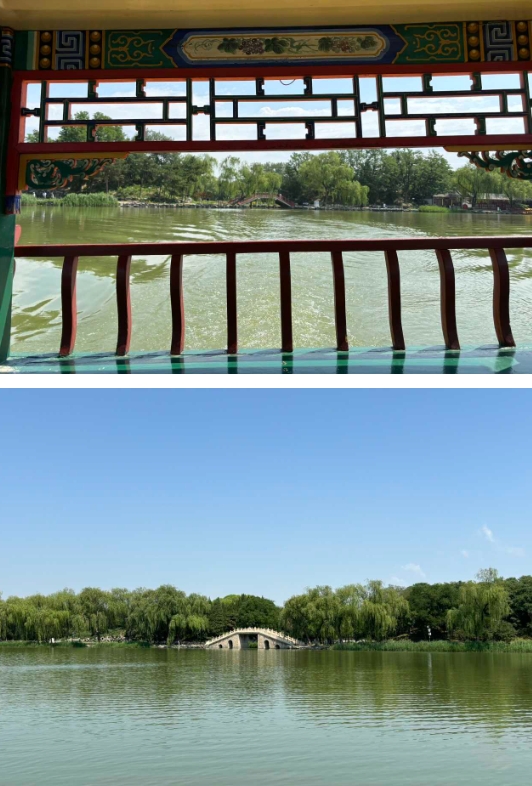
Take a cruise ship at the exit of the Western-Style Buildings Ruins Area
Tsinghua University – Peking University

The south gate of Tsinghua University

The east gate of Peking University
Yang Daye Mutton Hot Pot

Delicious food at Yang Daye Mutton Hot Pot restaurant
Badaling Great Wall
At the exit of the Badaling Great Wall high-speed rail station, turning left is for walking up to the Great Wall, and turning right is for taking the cable car. We didn’t choose to take the cable car as we felt it was unnecessary. Walking from the high-speed rail station, passing through the commercial street, and reaching the Great Wall security checkpoint takes about 15-20 minutes.
This is the gate (leading to the tourist bus parking lot, high-speed rail station, and S2 railway station) when coming and going by high-speed rail. Remember to also go through this gate when returning by high-speed rail. Don’t go the wrong way.

If coming and going by high-speed rail, go through this north gate

The hero monument at the entrance to climb the Great Wall, with the words “He who has not climbed the Great Wall is not a true man.”

The north section of the Great Wall
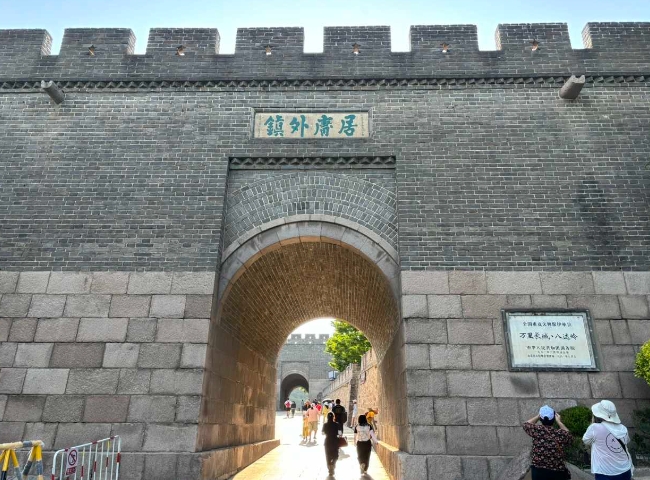
Don’t go out through this gate when going back
Day3 Temple of Heaven – Shichahai – Bird’s Nest and Water Cube
The Temple of Heaven is a sacrificial architectural complex where emperors of the Ming and Qing dynasties offered sacrifices to heaven and prayed for a good harvest. Built in 1420 (the eighteenth year of the reign of Emperor Yongle of the Ming Dynasty), although most of the existing buildings were built in the Qing Dynasty, its layout still remains as it was after the establishment of the system by Emperor Jiajing of the Ming Dynasty. The altar area covers an area of 2.73 million square meters and has two inner and outer altar walls. The south wall is square and the north wall is circular. The two altar walls divide the altar area into the inner altar and the outer altar. In the inner altar, there are ancient buildings such as the Hall of Prayer for Good Harvests, the Circular Mound Altar, the Imperial Vault of Heaven, and the Abstinence Palace where emperors fasted before offering sacrifices to heaven. In addition, there are landscapes such as the Vermilion Steps Bridge, the Corridor, the Seven-Star Stones, and the Nine-Dragon Cypress. In the outer altar, the main existing ancient building is the Divine Music Institution, which was the place where sacrificial music and rituals were rehearsed during the Ming and Qing dynasties. The Temple of Heaven is one of the highest-ranking, most complete, and most distinctive altar and temple architectural complexes remaining from ancient Chinese dynasties.
The following are the visiting routes for the east, south, west, and north gates summarized by netizens:
East entrance (5 minutes, 600 meters) → Temple of Heaven – Hall of Prayer for Good Harvests (3 minutes, 300 meters) → Vermilion Steps Bridge (3 minutes, 300 meters) → Echo Wall (1 minute, 30 meters) → Temple of Heaven – Circular Mound Altar (2 minutes, 200 meters) → South entrance (Zhaoheng Gate, 18 minutes, 1.2 kilometers) → Three Gates → Abstinence Palace (4 minutes → 350 meters) → Twin-ring Longevity Pavilion (10 minutes → 800 meters) → West exit or Twin-ring Longevity Pavilion (20 minutes → 1.4 kilometers) → Outer altar.
West entrance (7 minutes, 900 meters) → Abstinence Palace → Three Gates (18 minutes, 1.2 kilometers) → South entrance (Zhaoheng Gate) → Temple of Heaven – Circular Mound Altar (1 minute, 30 meters) → Echo Wall → (3 minutes, 300 meters) → Vermilion Steps Bridge (3 minutes, 300 meters) → Temple of Heaven – Hall of Prayer for Good Harvests (5 minutes, 550 meters) → Twin-ring Longevity Pavilion (8 minutes → 800 meters) → West exit.
Night view route (enter from the north gate and exit from the south gate) Walk for 4 minutes, 400 meters → Temple of Heaven – Hall of Prayer for Good Harvests (3 minutes, 300 meters) → Vermilion Steps Bridge (3 minutes, 300 meters) → Echo Wall (1 minute, 30 meters) → Temple of Heaven – Circular Mound Altar (2 minutes, 200 meters) → South exit (Zhaoheng Gate, 18 minutes, 1.2 kilometers).
South entrance (Zhaoheng Gate, 2 minutes, 200 meters) → Temple of Heaven – Circular Mound Altar (1 minute, 30 meters) → Echo Wall (3 minutes, 300 meters) → Vermilion Steps Bridge (3 minutes, 300 meters) Temple of Heaven – Hall of Prayer for Good Harvests (5 minutes, 550 meters) → Twin-ring Longevity Pavilion (4 minutes → 350 meters) → Abstinence Palace (7 minutes → 650 meters) → West exit.

Temple of Heaven

Temple of Heaven Park
Corridor Also known as the “Corridor for Offering Dishes” and “Seventy-two Connected Rooms”, it is 293 meters long and has 72 rooms. It is in the shape of a carpenter’s square and has continuous eaves and ridges. It is a passage connecting the Sacrificial Slaughter Pavilion, Divine Kitchen, and Divine Storehouse to the Altar of Prayer for Good Harvests. On the eve of the sacrifice ceremony, lanterns are hung in the corridor, and the offerings required for the ceremony are sent to the altar along the corridor.

Corridor
- The colors of the Hall of Prayer for Good Harvests.
Built in 1420 (the eighteenth year of the reign of Emperor Yongle of the Ming Dynasty), it is 讲究 that the upper eaves use blue glazed tiles, the middle layer is yellow, and the lower layer is green. The Hall of Prayer for Good Harvests is 38 meters high and is a circular hall with a gilded treasure top and triple eaves. The eaves are dark blue and are paved with blue glazed tiles. Because the sky is blue, it symbolizes the sky. The yellow walls represent the yellow earth. - Purposes.
The Hall of Prayer for Good Harvests was an important imperial sacrificial site in the Ming and Qing dynasties and was used to pray for a good harvest and national prosperity and people’s safety. Every year, the emperor would hold spring and winter sacrifices here to pray for a bountiful harvest and the well-being of the people. During the sacrificial ceremony, the emperor would offer sacrificial offerings and treasures and pray to the gods of heaven and earth to bless the country with peace and prosperity and a bountiful harvest. The Hall of Prayer for Good Harvests not only showcases the essence of ancient Chinese palace architecture art but also witnesses the historical evolution of ancient Chinese culture. - Structure.
The Hall of Prayer for Good Harvests is one of the earliest existing wooden palaces in China. Its main structure is composed of a large amount of wood and uses traditional architectural techniques such as mortise and tenon structure and dougong structure, making it have strong earthquake and wind resistance. The Hall of Prayer for Good Harvests is of brick and wood structure. The hall is 38 meters high and 32 meters in diameter. The triple eaves contract upward layer by layer in an umbrella shape.
The architecture is unique, without large beams, long purlins, or iron nails. Twenty-eight huge nanmu columns are arranged in a circle to support the weight of the hall roof. The colored paintings and murals are also very exquisite, depicting themes such as harvest and harmony. It integrates multiple cultural elements such as Han, Tibetan, and Mongolian, reflecting the diversity and openness of ancient Chinese architectural culture. The artistic decoration of the Hall of Prayer for Good Harvests is very exquisite, including various decorative methods such as wood carvings, brick carvings, and stone carvings, showing the essence of ancient Chinese architectural art. The colored paintings and murals inside the hall are also very exquisite, depicting themes such as harvest and harmony, reflecting the lives and beliefs of ancient Chinese people. - Symbols.
There are a total of thirty-six columns, symbolizing the thirty-six heavenly generals. The thunder god pillar under the treasure top symbolizes the emperor’s “unification of the world”. The four “Dragon Well Columns” in the inner circle symbolize the four seasons of spring, summer, autumn, and winter. The twelve “Golden Columns” in the middle circle symbolize the twelve months of a year.

Circular Mound Altar

Nine-Dragon Cypress, also known as “Nine Dragons Welcoming the Sage”, with a tree age of 620 years
Coming out of the Circular Mound Altar and walking towards the south gate, there are also ancient tree groups along the way. The ones with red signs are older, and the ones with green signs are younger. The tree below also has a tree age of 620 years.

This tree is 620 years old
Walking and shopping in Nanluoguxiang.

Nanluoguxiang signboard
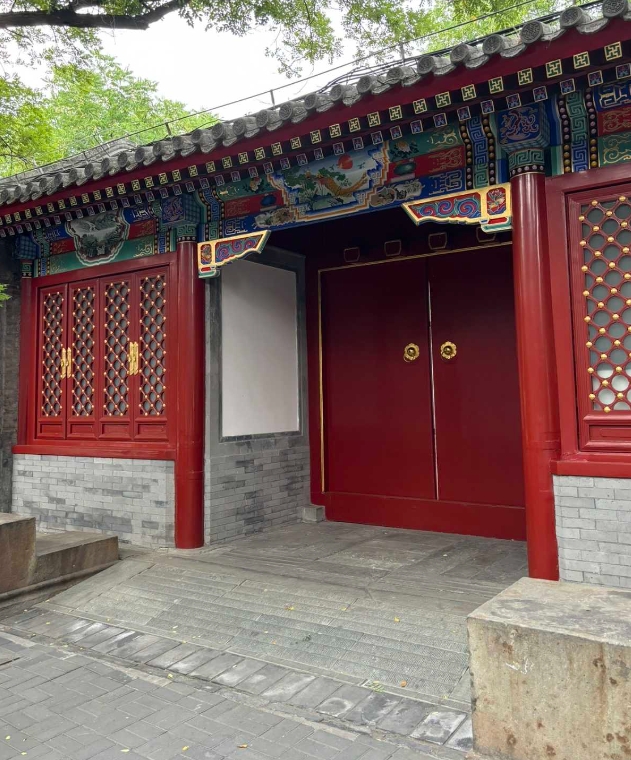
The residence of the last empress Wanrong before her marriage

Yandai Xiejie signboard

Century-old stewed food (Gulouyuan Store)
We made an appointment for the Tiananmen Rostrum from 8:30 to 10:30. We arrived at Tiananmen Square at 7:30. After queuing up for security check for nearly an hour and entering the square, there were relatively few people. We took pictures slowly and well on the square.
Monument to the People’s Heroes

Monument to the People’s Heroes
Tiananmen Square photographed from far to near.

Tiananmen Square in the distance

Tiananmen Square up close

Tiananmen Square up close
Tiananmen Rostrum
Through the underground passage on the side of the square, we came to the Tiananmen Rostrum. Tiananmen was built in 1417 (the fifteenth year of the reign of Emperor Yongle of the Ming Dynasty) and completed in 1420 (the eighteenth year of the reign of Emperor Yongle of the Ming Dynasty). Tiananmen was originally called Chengtianmen. The wooden plaque hanging on the rostrum was “The Gate of Receiving Heaven”, taking the meaning of “receiving heavenly fortune and being entrusted by heaven”. After being rebuilt in 1651 (the eighth year of the reign of Emperor Shunzhi of the Qing Dynasty), it was named Tiananmen. The wooden plaque hanging on the rostrum was “The Gate of Heaven”, containing the meanings of “being entrusted by heaven” and “governing the country and bringing peace to the people”. That is when the name Tiananmen has been used ever since. After Tiananmen was rebuilt in 1688 (the twenty-seventh year of the reign of Emperor Kangxi of the Qing Dynasty), it basically formed its current shape. Tiananmen is a typical double-eaved hip-roofed building, consisting of a city platform and a rostrum. The base of the city platform is a white marble Sumeru pedestal, on which a tall vermilion city platform is built. The city platform is large at the bottom and small at the top, in a trapezoidal shape. There are five arch-shaped door openings of different sizes in the middle. The middle door opening is the largest and only the emperor can enter and exit.
There is a pair of white marble pillars in front of and behind Tiananmen. The name of these pillars is Ornamental Pillars, also known as “watching pillars”. Stone beasts known as hou (pronounced hǒu, a beast that eats people in the north in Chinese mythology) squat on the ornamental pillars. There are cloud-shaped boards inserted horizontally below, and the pillar body is carved with cloud dragons. These ornamental pillars were built in the Yongle period of the Ming Dynasty at the same time as Tiananmen. So far, they have a history of more than 500 years. The distance between this pair of ornamental pillars is 96 meters. They appear dignified and beautiful, solemn and solemn, and are rare exquisite artworks. Each ornamental pillar is composed of a Sumeru pedestal base, pillar body, and dew-receiving plate. The total height is 9.57 meters, the diameter is 98 centimeters, and the weight is about 20,000 kilograms. The stone beasts on the ornamental pillars in front of Tiananmen face outside the palace. People call the stone beasts in front of the palace “Looking for the Emperor to Return”, meaning hoping that the emperor will not stay outside for a long time when going out for pleasure but should return to the palace quickly to handle state affairs. The stone beasts on the ornamental pillars at the back face inside the palace and are called “Looking for the Emperor to Go Out”, admonishing the emperor not to stay in the palace all the time seeking pleasure but should often go outside the palace to understand the sufferings of the people.

Ornamental Pillars are also known as “watching pillars”
When passing through the Jinshui Bridge, it was exactly 9 o’clock, and the fountains on both sides just started. After passing through the Jinshui Bridge, you need to store your bags first. Except for ID cards, mobile phones/cameras, nothing else can be brought into the rostrum.

Meeting and resting hall for leaders
This is the first wooden national emblem on Tiananmen.

The first wooden national emblem on Tiananmen
The Palace Museum
Passing through the Duanmen Gate and coming to the security checkpoint at the Meridian Gate, we found that people over 60 years old can go through the love passage. My family directly went through the love passage. I lined up beside. The security check took about ten minutes. When it was still more than ten minutes away from 11 o’clock, we were not stopped from entering.

Entrance of the Palace Museum
This is the flow of people on a weekday (Wednesday). I can’t imagine what it would be like to come to the Palace Museum on holidays. Because there are so many people, every point is photographed with a dark crowd in front. And it was cloudy on that day. It was gray and not photogenic at all. I didn’t have much interest in taking pictures either. My family was also very tired and not very able to walk. They were very anxious to go back, so we just walked around casually.

The flow of people at the Palace Museum on a weekday (Wednesday)
Our route: Meridian Gate, Hall of Supreme Harmony (commonly known as the Hall of Golden Chimes), Hall of Central Harmony, Hall of Preserving Harmony, Clock Museum, Nine-Dragon Screen, Treasure Gallery, Gate of Heavenly Purity, Palace of Heavenly Purity, Hall of Union, Palace of Earthly Tranquility, Imperial Garden, Gate of Divine Prowess.

Hall of Preserving Harmony, Hall of Imperial Supremacy, Palace of Heavenly Purity, Hall of Union

Clock made by the Qing Dynasty
Nine-Dragon Screen It is just outside the Treasure Gallery.

Nine-Dragon Screen
Treasure Gallery You also need to buy a separate ticket. It mainly exhibits various gold, silver, and jade articles of the Qing Dynasty. The space inside the gallery is long and narrow and there are a lot of people. Basically, it is a line of people moving at a snail’s pace close to each other. So I just took a few pictures casually. When there are too many people, I don’t want to look at anything.

Treasure Gallery
After exiting through the Gate of Divine Prowess, if you still have energy, Jingshan Park opposite is recommended by many people. Climbing up there, you can see the panoramic view of the Forbidden City. There is a loudspeaker on the square outside the Gate of Divine Prowess constantly broadcasting, asking you to turn right to take a sightseeing bus. There is traffic control in this area, so you can’t get a taxi. After checking online, it is said that this sightseeing bus charges 20 yuan per person for a one-yuan ride. It is really very disappointing. In fact, if you turn left 20 meters, there is a bus stop. Just take a bus for one or two stops and then get off to take a taxi or subway. We took Bus No. 101 and transferred to Line 5 and returned to the homestay.
We directly took a Didi ride from the homestay to Beijing Daxing International Airport. After passing through security, the boarding gate has not been determined yet. There is still plenty of time. First, we went to Yangyang Chinese Cuisine at boarding gate B20. Each of us ordered a bowl of noodles. A bowl costs more than 20 yuan. The taste is quite good. After eating the noodles, we went to the boarding gate in area D to wait. We found that Heytea in area D is also at the normal store price. We packed milk tea and took it on the plane. For the first time, I ate food at the normal store price at the airport. I really want to give a big thumbs up to Beijing Daxing International Airport.